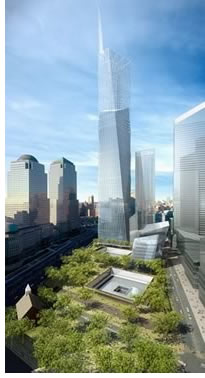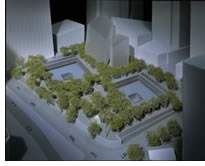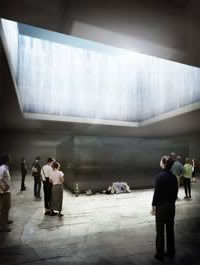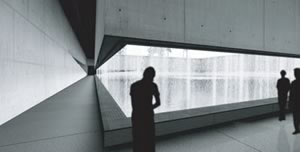

World Trade Center Memorial Unveiled
 A
13-member jury on January 14 revealed their selection of “Reflecting
Absence,” a memorial design by New York City Housing Authority architect
Michael Arad and landscape architect Peter Walker, to honor the victims
of the 2001 terrorist attacks and the 1993 bombing of the World Trade
Center. The design encompasses two reflecting pools that mark the spot
of the towers’ footprints, surrounded by a large plaza filled with
vibrant greenery.
A
13-member jury on January 14 revealed their selection of “Reflecting
Absence,” a memorial design by New York City Housing Authority architect
Michael Arad and landscape architect Peter Walker, to honor the victims
of the 2001 terrorist attacks and the 1993 bombing of the World Trade
Center. The design encompasses two reflecting pools that mark the spot
of the towers’ footprints, surrounded by a large plaza filled with
vibrant greenery.
Although the jury, which included architects Maya Lin and Enrique Norten, and landscape architect Michael Van Valkenburgh, chose “Reflecting Absence” from a group of eight semi-finalists last week, officials waited until January 14 to unveil the plan so several changes—including the addition of groves of trees to the plaza and an underground center to house artifacts from the attack—could be made to Arad’s original design. To that end, Walker, a former chair of the Harvard Graduate School of Design landscape architecture department, joined the team. Walker and Arad worked with Daniel Libeskind, the architect of the World Trade Center site plan, to fine-tune their proposal.
 Solemnity
of descent
Solemnity
of descent
The revised design offers pools of water submerged 30 feet below street
level and fed by a constant stream of water, plus an underground museum
and a cultural center at the northeast corner of the site. The jury noted,
“In our descent to the level below the street, down into the outlines
left by the lost towers, we find that absence is made palpable in the
sight and sound of thin sheets of water falling into reflecting pools,
each with a further void at its center. We view the sky, now sharply outlined
by the perimeter of the voids, through this veil of falling water.”
The architects explain that the design allows visitors to take in the
“massive expanse of the original foundations” as they make
their way along the western edge of the site and by a deep fissure that
exposes the slurry wall from plaza level to bedrock and provides access
via a stairway to an underground interpretive center located at bedrock.
The center would include the twisted steel beams, a crushed fire truck,
personal effects, exhibition areas, lecture halls, and a research library.
 There
is also room for private reflection. The jury noted that loved ones “will
be able to mourn privately in a chamber with a large stone vessel containing
unidentified remains of victims that will rest at the base of the void,
directly beneath an opening to the sky above.”
There
is also room for private reflection. The jury noted that loved ones “will
be able to mourn privately in a chamber with a large stone vessel containing
unidentified remains of victims that will rest at the base of the void,
directly beneath an opening to the sky above.”
Living memorial
“Bordering each pool is a pair of ramps that lead down to the memorial
spaces. Descending into the memorial, visitors are removed from the sights
and sounds of the city and immersed in a cool darkness. As they proceed,
the sound of water falling grows louder, and more daylight filters in
from below. At the bottom of their descent, they find themselves behind
a thin curtain of water, staring out at an enormous pool. Surrounding
this pool is a continuous ribbon of names. The enormity of this space
and the multitude of names that form this endless ribbon underscore the
vast scope of the destruction. Standing there at the water’s edge,
looking at a pool of water that is flowing away into an abyss, a visitor
to the site can sense that what is beyond this curtain of water and ribbon
of names is inaccessible,” the architects noted.
The architects left it so that the names of the deceased are in no particular
order, an expression of the randomness and the “haphazard brutality”
of the deaths and allows for flexibility in the way they are placed. For
instance, the designer notes, siblings could be placed next to one another.
 The
jury recommended that the city also make provisions to continue the “Tribute
of Light,” the silhouetted towers that reach into the Manhattan
skyline and mark the anniversary of the September 2001 attacks.
The
jury recommended that the city also make provisions to continue the “Tribute
of Light,” the silhouetted towers that reach into the Manhattan
skyline and mark the anniversary of the September 2001 attacks.
The World Trade Center Memorial Foundation has been created to raise funds for the memorial and will be formally launched later this month.
Copyright 2004 The American Institute of Architects.
All rights reserved. Home Page ![]()
![]()
 |
||
|
|
||